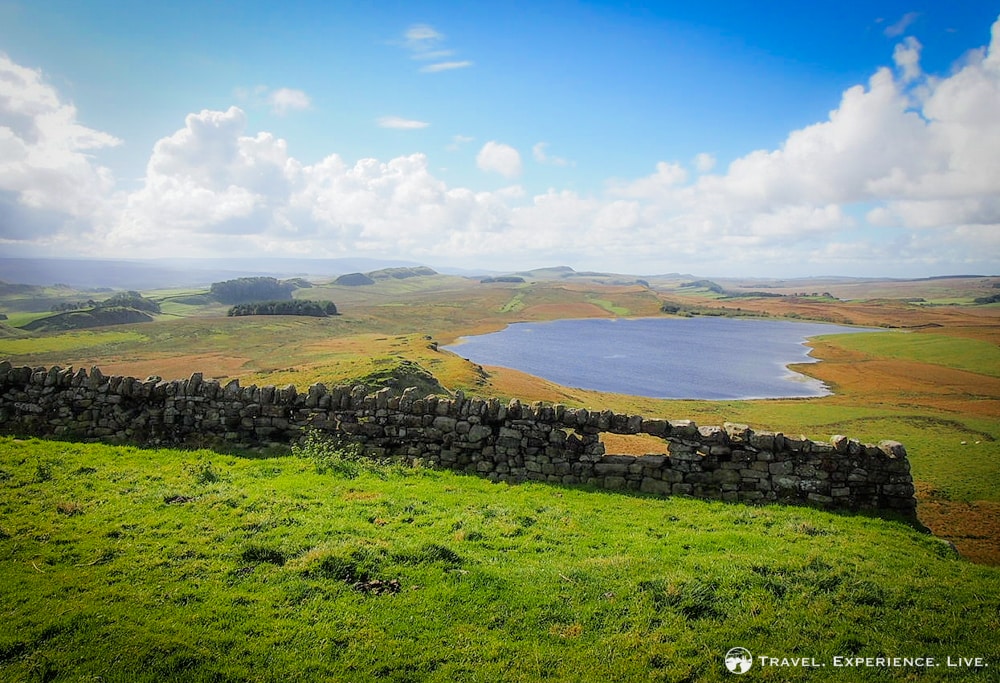Fun Things to Do When Visiting Pinnacles National Park, California
The Pinnacles Volcanic Formation is so remarkable President Theodore Roosevelt decided to protect the area in 1908 by making it a national monument. Decades later, in 2013, President Obama re-designated it as a national park.
Much less-known and less-visited than the superstar national parks in California, such as Yosemite, Death Valley, Sequoia and Joshua Tree, Pinnacles National Park is about 3 hours south of San Francisco and 5.5 hours north of Los Angeles.
After a peaceful drive through the rolling Salinas Valley farmlands, you’ll arrive at this unique park, home to monoliths and rock spires—the namesake pinnacles.
Pinnacles National Park lies right on the San Andreas Fault and encompasses a part of an ancient and extinct volcanic field.
The fault split the volcano in half, dragging Pinnacles National Park’s jagged rock formations to the north, while the other part stayed put, currently about 195 miles to the southeast.
It may be one of the smallest national parks in the U.S., but there are plenty of things to do in Pinnacles National Park to make it a worthwhile weekend trip destination from California’s largest cities.
It’s also the perfect stopping point on longer road trips, a relatively quiet park that offers beautiful scenery and fun outdoor activities.
This blog post about things to do in Pinnacles National Park pcontains affiliate links. You can read more about our Terms of Use / Disclosure here.
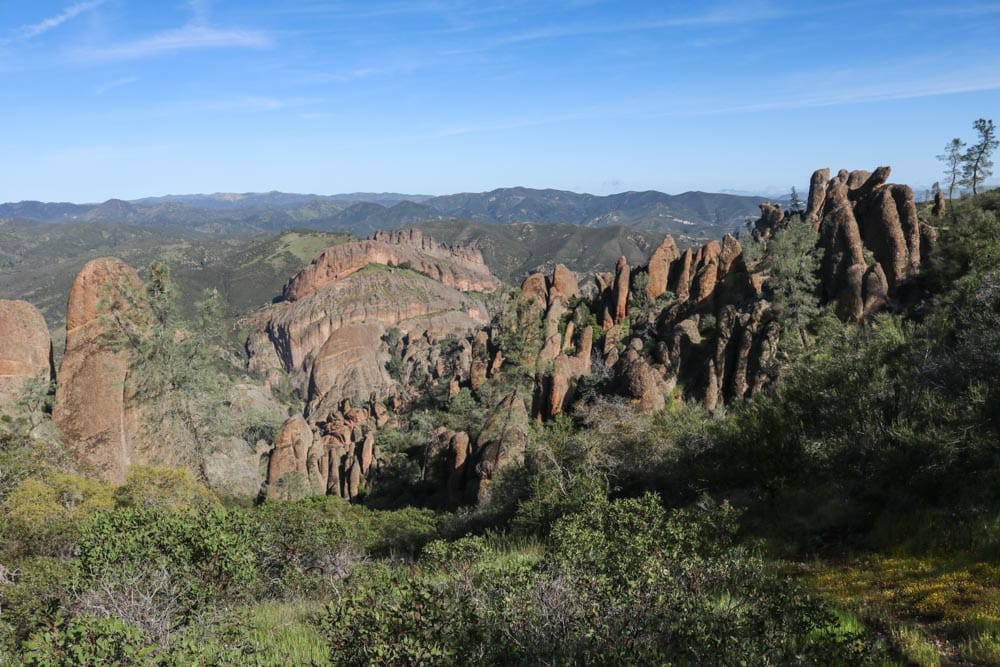
Pinnacles National Park East Vs West
There are two separate entrances to Pinnacles National Park, one in the east and one in the west. There’s no road that connects them.
The East Entrance is where I recommend you enter. This is where you’ll find the Pinnacles National Park Visitor Center, the park’s only campground, exhibits, a small store, picnic areas, drinking water and restrooms.
The East Entrance lies off of Highway 25 between the towns of Hollister and King City, both located about 30 miles (50 kilometers) in either direction. These towns are the only places to get gas and groceries in the area, so you might want to fuel and stock up before heading to the park.
The West Entrance is another option, but the road to the west side’s only trailhead is much more winding and narrower, which makes it less suitable for RVs and larger vehicles.
Again, East Pinnacles is where you want to be, both when visiting Pinnacles National Park for the day and overnight.
Therefore, I’ll approach all the best things to do in Pinnacles National Park in this post from the perspective of someone who’s entering at the East Entrance.
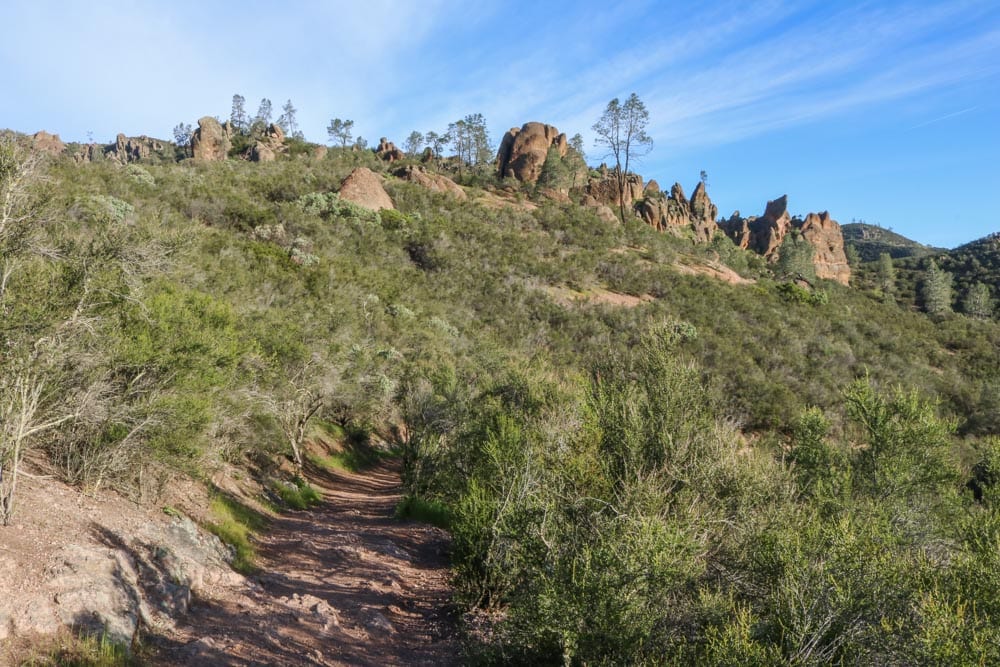
6 Things to Do in Pinnacles National Park, California
The Pinnacles National Park area has its fair share of tales of bandits, cattle rustlers and outlaws—this is California, after all.
Those days are long gone, of course, and the park’s most famous residents nowadays are California condors.
Bird watching is one of the top Pinnacles National Park activities, as are hiking, camping, rock climbing, enjoying a variety of wildflowers, and admiring amazing geological formations, such as caves and spires.
Walk Through a Talus Cave
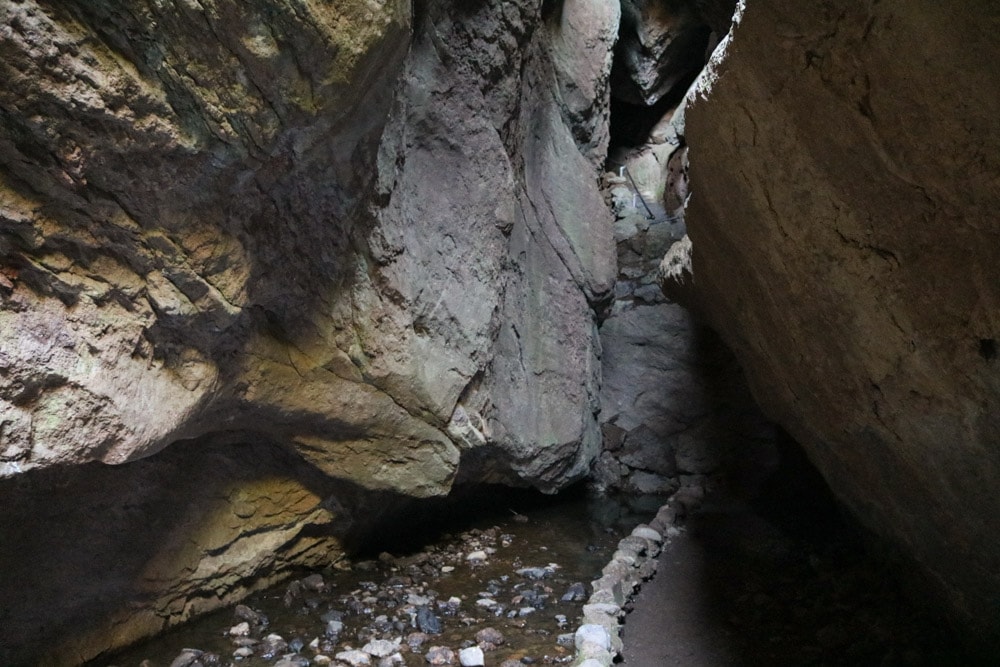
The tectonic movement that dragged Pinnacles National Park northward also created the park’s characteristic talus caves.
These caves are not your typical caves in the national parks—many of which are huge holes in the ground—but are actually narrow gorges that filled up with huge boulders falling from slopes. Those boulders wedged in the gorge, leaving an open space below.
Pinnacles National Park is home to two such talus caves. There’s one in the east side and one in the west side, respectively known as the Bear Gulch Cave and Balconies Cave.
You can walk through both caves on a fun and sometimes-dark trail—definitely one of the most fun things to do in Pinnacles National Park.
The Bear Gulch Cave Trail is by far the most popular trail, accessible from the Bear Gulch parking lot and leading to Bear Gulch Reservoir.
Note that Bear Gulch Cave is home to a colony of Townend’s big-eared bats, which are listed as a sensitive species by the state of California and are, as such, protected.
This may cause temporary closures of the cave, particularly from mid-May to mid-June when the bats are raising their young.
Rock Climb a Cliff or Rock Spire
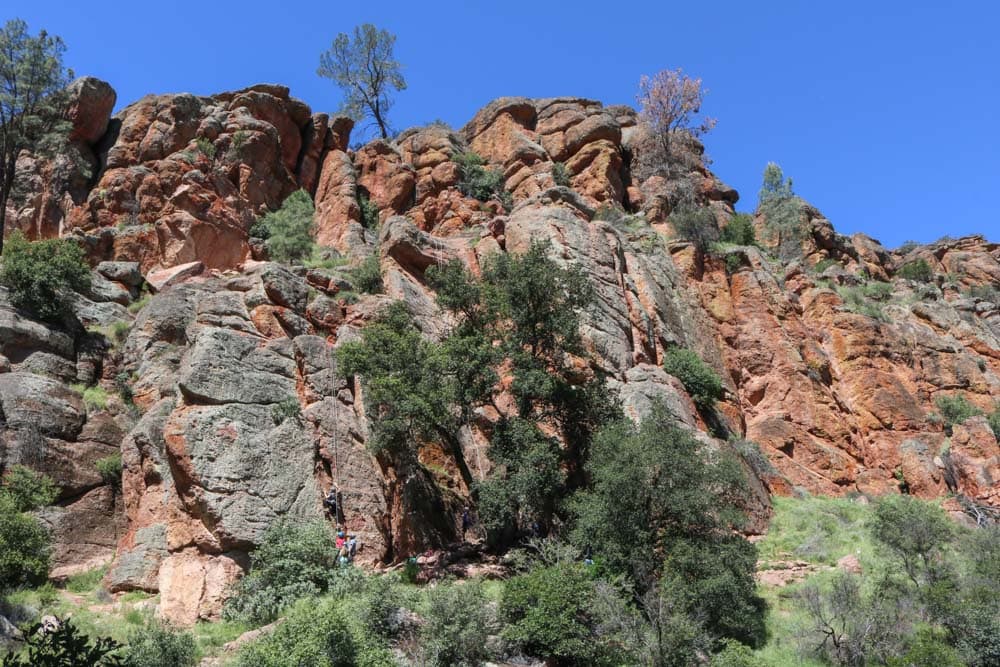
Rock climbers can explore the Pinnacles National Park rock formations on literally hundreds of climbing routes, both in the east and west side of the park.
The east side has numerous beginner and intermediate routes, while the more advanced climbs are in the west side’s higher rock formations.
Note that, while climbing in this park can be epic, the volcanic rocks of Pinnacles are more much brittle and weaker than the granite or basalt rock you may be used to.
Read the Pinnacles Climber’s Safety Advisory before heading out.
See Dozens of Birds, Including California Condors
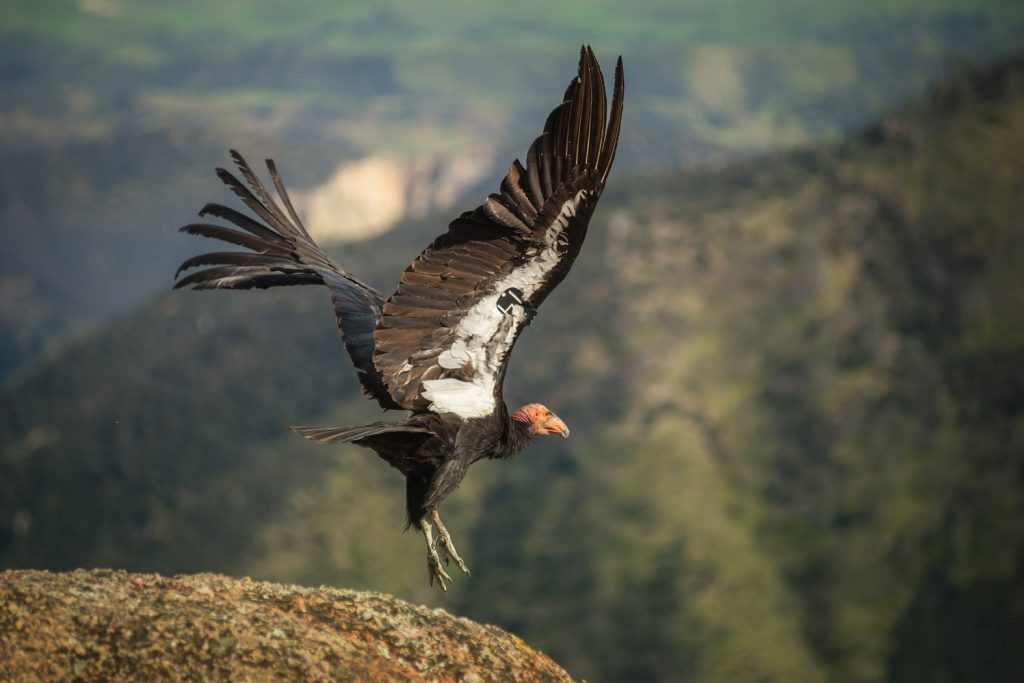
Pinnacles National Park is a superb destination for birds of prey and woodland birds.
The park made my list of best national parks for bird watching because of its population of California condors. It’s one of only a few national parks where you can see those majestic birds.
In fact, Pinnacles is the only national park that manages a release site for California condors bred in captivity. Your best chances of spotting one (or more) is on the High Peaks Trail (see below).
Other birds you might see include California quails, turkey vultures, canyon wrens, greater roadrunners, acorn woodpeckers, golden eagles, and prairie falcons.
Enjoy Spring Wildflowers
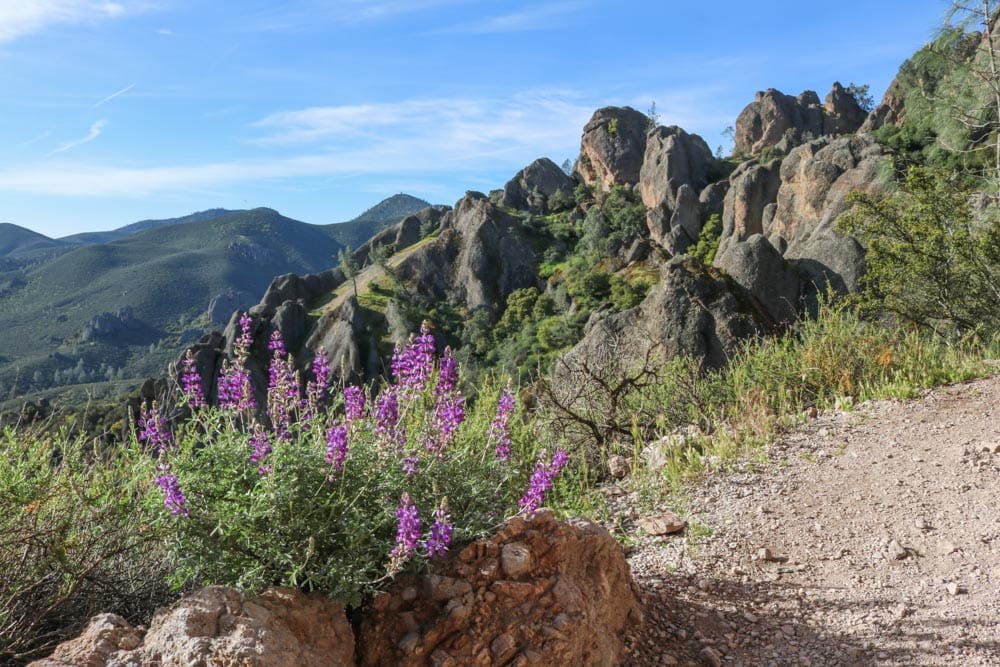
Fertile soil, varied terrain and winter rainfall combine to create perfect growing conditions for a huge diversity of wildflowers and other flora.
The peak wildflower bloom in Pinnacles National Park is from March through May. No less than 80% of the park’s plants are in bloom during those three months.
Depending on precipitation and temperature, the blooming season can start as early late-January and continue well into June.
The best period to see the Pinnacles National Park wildflowers is late-March through mid-April. This time of year also boasts the most comfortable temperatures for humans, so I recommend visiting then.
Go for a hike and look for California poppies, monkeyflowers, baby blue-eyes, fiesta flowers, suncups and bush lupines.
Hike the High Peaks Trail
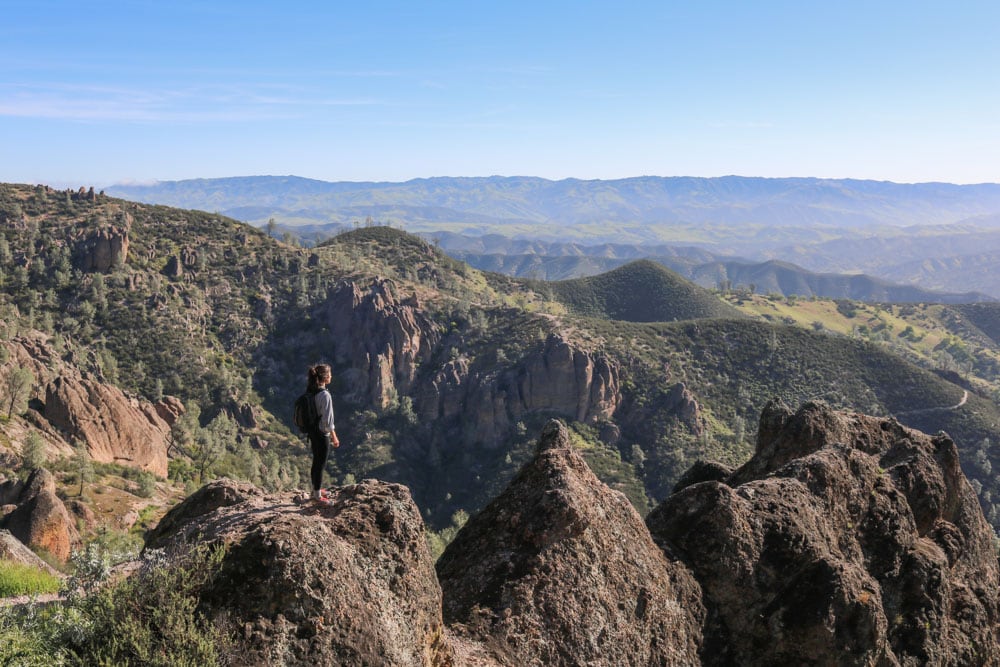
Hiking is definitely one of the most popular things to do in Pinnacles National Park, the best way to explore its stunning rock formations.
With more than 30 miles (50 kilometers) of trails, there’s a number of great day hikes in Pinnacles National Park. Most trails intersect at some point, making it possible to piece together a hike that suits your physical ability perfectly.
The one trail that you should use as the base for day hikes in the park is the High Peaks Trail.
This is a one-way trail that can be made into a couple of loops of various lengths by combining it with other Pinnacles National Park trails.
- High Peaks – Condor Gulch Loop: 5.3 miles (8.5 kilometers)
- High Peaks – Bear Gulch Loop: 6.7 miles (10.8 kilometers)
- High Peaks – Balconies Cave Loop: 4 miles (13.5 kilometers)
During my visit, I hiked the High Peaks-Condor Gulch Loop.
It’s short enough for a fun morning or afternoon hike, yet there are also some steep sections on the way to keep things interesting. And the views are out of this world. It’s an amazing day hike in Pinnacles National Park.
Camp at the Pinnacles Campground
Pinnacles is quite a ways from any major city, so many visitors will want to spend the night. There’s no lodging inside the park and as far as Pinnacles National Park camping options go, there’s just one—the Pinnacles Campground.
Operated by a concessionaire, the Pinnacles Recreation Co., the Pinnacles Campground is only accessible from the East Entrance.
There are 134 campsites, all equipped with a picnic table and fire ring. Both tent sites and RV sites are available. Other amenities are a camp store, hot showers, flush toilets, a pool and even WiFi.
Pinnacles National Park Guide: Q&As
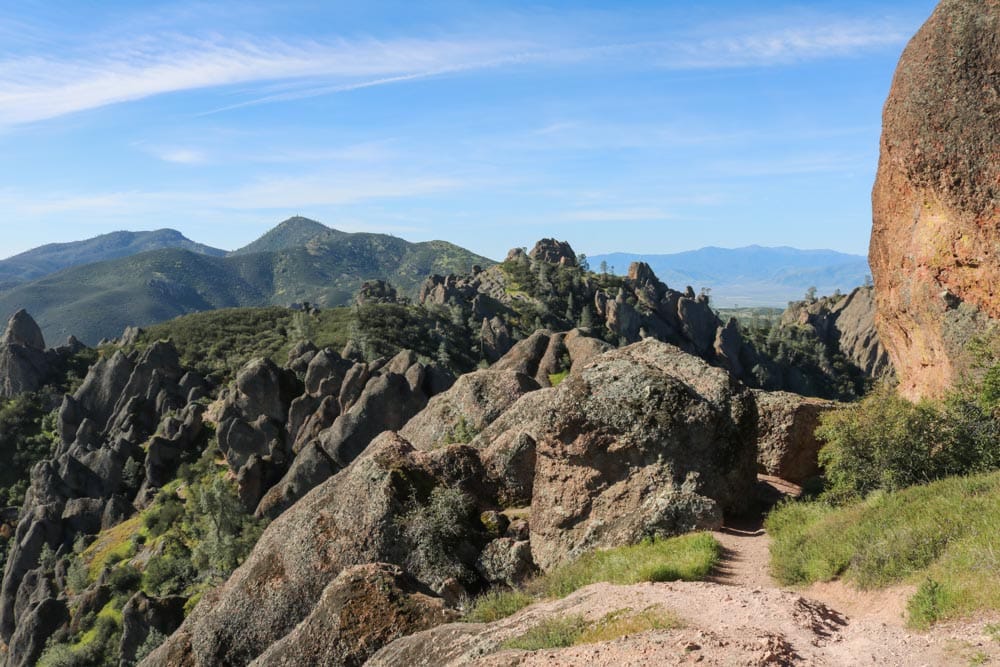
What Is the Pinnacles National Park Entrance Fee?
As many other U.S. national parks, Pinnacles National Park charges an entrance fee to most visitors. All revenue stays within the park, though, and is used for maintenance, resource protection and research.
A pass is valid for 7 days from the date of purchase. Passes allow entrance to all passengers of cars and motorcycles.
- Vehicle: $30
- Motorcycle: $25
- Bicycle or pedestrian: $15
Check up-to-date entrance fees on the National Park Service website.
An alternative I personally always recommend is purchasing an America the Beautiful Annual Pass. This federal recreational lands pass costs only $80 and offers unlimited access to all federal recreation sites all across the U.S.
That includes all 425+ National Park Service sites, but also national forests, grasslands, monuments, and Bureau of Land Management lands.
Where Is Pinnacles National Park?
Pinnacles is one of the closest national parks to San Francisco, Monterey Bay and the famous Big Sur coast. It’s also an accessible national park from Los Angeles (if you’re up for a longer road trip).
Here are some distances and estimated driving times from nearby urban centers to the East Entrance.
- San Francisco to Pinnacles National Park: 125 miles / 3 hours
- San Jose to Pinnacles National Park: 78 miles / 2 hours
- Salinas to Pinnacles National Park: 58 miles / 1.5 hours (or 38 miles / 45 minutes to the west side)
- Sacramento to Pinnacles National Park: 185 miles / 3.5 hours
- Los Angeles to Pinnacles National Park: 300 miles / 5.5 hours
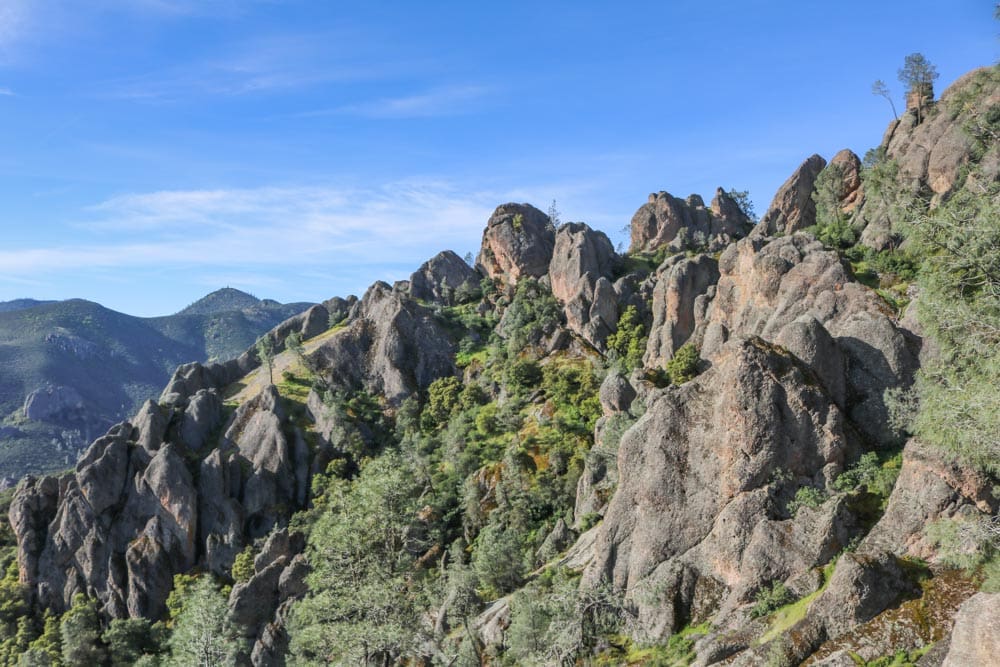
What Are the Pinnacles National Park Hours?
East Pinnacles
The East Entrance is open 24/7 and entrance fees are collected throughout the entire year (except on the handful of admission-free days).
Both the Pinnacles Visitor Center and Pinnacles Campground store are open daily from 9.30 am to 5 pm. The Bear Gulch Nature Center is open every day between 10 am and 4 pm.
West Pinnacles
The West Entrance is open every day from 7.30 am to 8 pm—it’s closed at night. Fees are also collected all-year round. Note that camping is not allowed anywhere in the west side.
What Is the Best Time to Visit Pinnacles National Park?
Pinnacles National Park’s most popular time of the year is from mid-February to late-May. Spring sees the most comfortable temperatures, while abundant wildflowers cover the slopes.
Make sure to book a campsite at the Pinnacles National Park campground way in advance if you’re planning on visiting the park in the busy season. The campground is typically full, especially on weekends.
I strongly recommend visiting Pinnacles National Park on a weekday in March or April. Those days tend to be relatively quiet compared with Saturdays and Sundays.





